













|
Copyright © 1995-1999 by Rosanna L. Hamilton. All rights reserved.
| Meteoroids & Meteorites |
|
Introduction Pictures of Meteorites References |
| Meteorite Science |
|
Terrestrial Impact Craters Life from Mars: The Discovery Meteorite Image Index |
| Educator's Guides |
|
Meteoroids & Space Debris Impact Craters Micrometeorites |
| Other Resources |
|
Asteroid/Comet Impact Hazards |
One of the primary goals of studying meteorites is to determine the history and origin of their parent bodies. Several achondrites sampled from Antarctica since 1981 have conclusively been shown to have originated from the moon based on compositional matches of lunar rocks obtained by the Apollo missions of 1969-1972. Sources of other specific metorites remain unproven, although another set of eight achondrites are suspected to have come from Mars. These meteorites contain atmospheric gases trapped in shock melted minerals which match the composition of the Martian atmosphere as measured by the Viking landers in 1976. All other groups are presumed to have originated on asteroids or comets; the majority of meteorites are believed to be fragments of asteroids.
| Meteorite Types & Percentage that Falls to the Earth | |
|---|---|
|
|
Meteorites have proven difficult to classify, but the three broadest groupings are stony, stony iron, and iron. The most common meteorites are chondrites, which are stony meteorites. Radiometric dating of chondrites has placed them at the age of 4.55 billion years, which is the approximate age of the solar system. They are considered pristine samples of early solar system matter, although in many cases their properties have been modified by thermal metamorphism or icy alteration. Some meteoriticists have suggested that the different properties found in various chondrites suggest the location in which they were formed. Enstatite chondrites contain the most refractory elements and are believed to have formed in the inner solar system. Ordinary chondrites, being the most common type containing both volatile and oxidized elements, are thought to have formed in the inner asteroid belt. Carbonaceous chondrites, which have the highest proportions of volatile elements and are the most oxidized, are thought to have originated in even greater solar distances. Each of these classes can be further subdivided into smaller groups with distinct properties.
Other meteorite types which have been geologically processed are achondrites, irons and pallasites. Achondrites are also stony meteorites, but they are considered differentiated or reprocessed matter. They are formed by melting and recrystallization on or within meteorite parent bodies; as a result, achondrites have distinct textures and mineralogies indicative of igneous processes. Pallasites are stony iron meteorites composed of olivine enclosed in metal. Iron meteorites are classified into thirteen major groups and consist primarily of iron-nickel alloys with minor amounts of carbon, sulfur, and phosphorus. These meteorites formed when molten metal segregated from less dense silicate material and cooled, showing another type of melting behavior within meteorite parent bodies. Thus, meteoritescontain evidence of changes that occurred on the parent bodies from which they were removed or broken off, presumably by impacts, to be placed in the first of many revolutions.
The motion of meteoroids can be severely perturbed by the gravitational fields of major planets. Jupiter's gravitational influence is capable of reshaping an asteroid's orbit from the main belt so that it dives into the inner solar system and crosses the orbit of Earth. This is apparently the case of the Apollo and Vesta asteroid fragments.
Particles found in highly correlated orbits are called a stream components and those found in random orbits are called sporadic components. It is thought that most meteor streams are formed by the decay of a comet nucleus and consequently are spread around the original orbit of the comet. When Earth's orbit intersects a meteor stream, the meteor rate is increased and a meteor shower results. A meteor shower typically will be active for several days. A particularly intense meteor shower is called a meteor storm. Sporadic meteors are believed to have had a gradual loss of orbital coherence with a meteor shower due to collisions and radiative effects, further enhanced by gravitational influences. There is still some debate concerning sporadic meteors and their relationship with showers.
| Pictures of Meteorites |
|---|
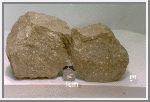 Chondrite Meteorite
Chondrite Meteorite
This meteorite was collected from the Allan Hills in
Antarctica. Meteorites are bits of rock that are captured by a planet's
gravity and pulled to the surface. This meteorite is of a type named
chondrite and is thought to have formed at the same time as the planets
in the solar nebula, about 4.55 billion years ago.
(Courtesy NASA/JPL)
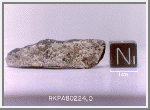 Achondrite Meteorite
Achondrite Meteorite
Discovered at Reckling Peak, Antarctica, this type of meteorite is
known as an achondrite. It has a basaltic
composition and was probably
formed when an asteroid melted about 4.5 billion years ago. The
asteroid broke up some time later and this small piece of the asteroid
was captured by Earth's gravity and fell to the ground.
(Courtesy NASA/JPL)
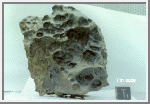 Iron Meteorite
Iron Meteorite
This iron meteorite was found at Derrick Peak, Antarctica. This type of
meteorite gets its name because it is mostly made of the elements iron
and nickel. This sample is probably a small piece from the core of a
large asteroid that broke apart. (Courtesy NASA/JPL)
 Martian Meteorite
Martian Meteorite
Even though this meteorite was collected in Elephant Moraine,
Antarctica in 1979, some scientists believe that it came from the
planet Mars. The minerals found in this rock are similar to those that
scientists expect to find in rocks on Mars. This meteorite also
contains vesicles, or shiny pockets, which contain air very much like
the air measured on Mars by the Viking spacecraft. This meteorite is
180 million years old. (Courtesy NASA/JPL)
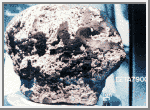 A Martian Meteorite
A Martian Meteorite
This meteorite, called EETA 79001, was found on the ice in Antarctica,
and is quite likely from Mars. For scale, the cube at the lower right is
1 centimeter on a side. The meteorite is partly covered by a black glassy
layer, the fusion crust. The fusion crust forms when the meteorite
enters the Earth's atmosphere at high speed. Friction heating
melts the outer portion of the meteorite. Inside, the meteorite is gray.
It is a basalt, very similar to basalts
found on Earth. It formed in a volcanic eruption about 180 million
years ago. This meteorite is quite likely from Mars because it contains
a small amount of gas that is chemically identical to the Martian
atmosphere.
(Courtesy LPI)
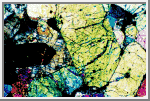 Microscopic View of a Martian Meteorite
Microscopic View of a Martian Meteorite
Rocks are often made of small mineral grains that can't be seen clearly
without a microscope. To see these small grains, scientists grind and
polish rock samples very thin (0.03 millimeters) so light can pass
through them. This microscopic view, 2.3 millimeters (.09 inches) across,
is in false color, produced by holding polarizing filters above and below
the microscopic slide. These filters cause different minerals to have
distinctive colors, allowing easy identification of the minerals.
Most of this meteorite (in yellow, green, pink, and black) is the
mineral olivine, which is common in some basaltic rocks. The striped
grain near the center is the mineral pyroxene.
(Courtesy Allan Treiman, LPI)
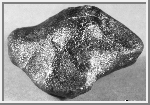 Vesta Meteorite
Vesta Meteorite
This meteorite is assumed to be a sample of the crust of the asteroid
Vesta,
which is only the third solar system object beyond Earth where scientists
have a laboratory sample (the other extraterrestrial samples are from Mars
and the Moon). The meteorite is unique because it is made almost entirely of
the mineral pyroxene, common in lava flows. The meteorite's mineral grain
structure also indicates it was once molten, and its oxygen isotopes
are unlike oxygen isotopes found for all other rocks of the Earth and
Moon. The meteorite's chemical identity points to the asteroid Vesta
because it has the same unique spectral signature of the mineral
pyroxene.
Most of the identified meteorites from Vesta are in the care of the
Western Australian Museum. This 1.4 pound (631 gm) specimen comes from
the New England Meteoritical Services. It is a complete specimen
measuring
9.6 x 8.1 x 8.7 centimeters (3.7 x 3.1 x 3.4 inches),
showing the fusion crust, evidence of the last stage in its journey to
Earth.
(Photo Credit: R. Kempton, New England Meteoritical Services)
| References |
|---|
Beatty, J. K. and A. Chaikin. The New Solar System. Massachusetts: Sky Publishing, 3rd Edition, 1990.
Maran, Stephen P. The Astronomy and Astrophysics Encyclopedia. New York: Van Nostrand Reinhold, pp. 430-445, 1992.
Seeds, Michael A. Horizons. Belmont, California: Wadsworth, 1995.
Views of the Solar System Copyright © 1997-2000 by Calvin J. Hamilton. All rights reserved. Privacy Statement.